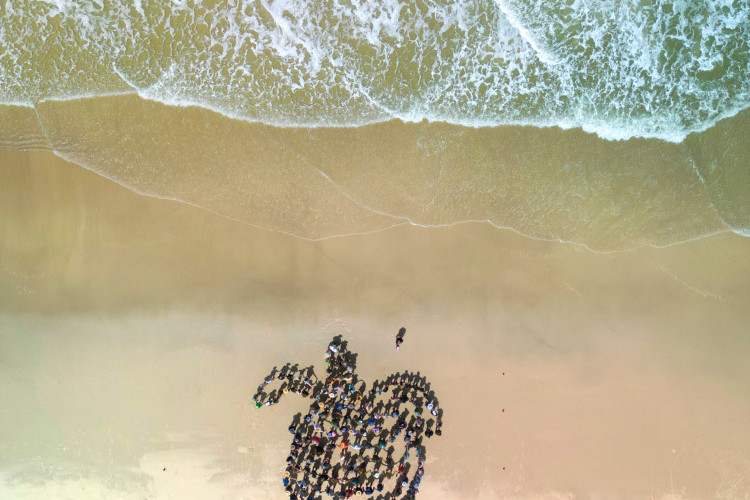3 December, 2022
Giant turtle sighted on Bribie Island
TO celebrate the start of the turtle nesting season, the Bribie Island Environmental Protection Association (BIEPA) worked with local artist Geoff Ginn to corral over 200 locals into a giant turtle on Woorim Beach on Sunday December 4.

The man-made turtle artwork, which was captured by drones, aimed to raise awareness and educate Moreton Bay residents on how they can protect endangered turtle species.
“I was pleased to make a simple but very useful giant turtle outline that brought together a joyous and thoughtful crowd to highlight this risky 100-metre journey turtles, both large and small, take across our beaches many times each year,” Geoff said.
Bribie Island Turtle Trackers (BITT) team leader Diane Oxenford said they want to educate the Moreton Bay community about how they can protect turtles as they come ashore to nest in beach dunes during the summer months.
“For successful incubation, turtles need healthy, warm sand beach dunes, protected from pedestrian traffic, disturbance and ratification light pollution,” Diane said.
“It is also important to be aware that the dunes are an essential habitat providing food and shelter for resident and migratory birds and other wildlife as well.”
The migratory species that visit Moreton Bay annually — birds, turtles, dugongs, whales, and so on — have been protected since 1991 by the United Nations convention on the Conservation of Migratory Species.
Since 1993, Moreton Bay has also been protected under the United Nations RAMSAR Convention on Wetlands of International Importance.
The loggerhead turtles of the South Pacific Ocean, which nest on Queensland beaches, are further protected by a United Nations Single Species Action Plan 2015, and by the Australian Government’s Recovery Plan for Marine Turtles 2017- 2027.
BIEPA president Richard Ogden said the whole community is recognising the unique value of Bribie Island, particularly for nesting turtles.
“We must work together to look after our remaining wildlife and natural habitat,” Richard said.
The Pumicestone Indigenous Education and Employment Council were also in attendance, welcoming locals to country with a customary smoking ceremony, as well as a clapstick and didgeridoo performance.
BIEPA would like to thank everyone who came to support the event and help raise awareness around protecting mothers and their hatchlings.
To help the success of these endangered species, BITT’s have provided the following recommendations:
1. Remember, turtles have survived for more than 150 million years, so the species has been able to adapt to many changes in their environment. They rarely need our help and should be left alone to do what they do best when visiting our shores to nest.
2. If you encounter a nesting turtle or hatchlings on Bribie Island (Yarun), immediately phone Bribie Island Turtle Trackers on 0438 111 163. They will monitor and collect data for scientists. If the turtle leaves before a BITT member arrives, take the GPS coordinates and mark the nest area with sticks. Try not to walk on turtle tracks and the nesting site, as these provide important information for the BITTs.
3. Give any nesting turtle a wide berth, staying behind her and out of her line of sight; nesting turtles are easily spooked. The BITTs monitor the mother and her nest to ensure they remain safe and protected, relocating the eggs if threatened.
4. Artificial lights can disorient turtles, affecting their ability to see the brighter horizon over the ocean which they use to find their way back out to sea after laying. Newly emerged hatchlings are similarly distracted and will head towards bright artificial light when they need to be heading to the ocean horizon. Artificial lights on the beach should be avoided as they will also discourage females coming ashore.
5. Remember to keep off the fragile dunes. Healthy, vegetated and stable dunes
provide protection against storm surges as well as habitat for coastal wildlife including resident and migratory birds and endangered turtle nests.
6. If driving on the beach, please avoid turtle nesting beaches at night as their nesting and hatching habits are mostly nocturnal. Also avoid driving at high tide on soft sand as there could be nests, and it creates deep ruts that turtle hatchlings cannot negotiate to get to the ocean, making them vulnerable to predators and exhaustion. Soft sand will build new dunes, and driving on this area prevents the growth of protective, vegetated and stable dunes. It’s best to drive on hard sand at low tide during daylight hours.
Beyond threats on the beaches at nesting time, ocean-related threats to turtles include plastic pollution, vessel strike, entanglement in crab pot lines and fishing gear, and poor water quality effecting their health and diets.
BIEPA has proactive project teams tackling many of those threats — consider joining one of our teams to give turtles and other marine wildlife a better chance.
To report sick, injured, or dead turtles, dolphins, dugongs or whales around Bribie Island, phone a local Bribie-based Government- accredited volunteer on 0438 111 163.
A blog post published by BIEPA regarding the turtle nesting season celebration can be found through the following link: https://www. biepa.online/post/giant- turtle-sighted-on-bribie- island

